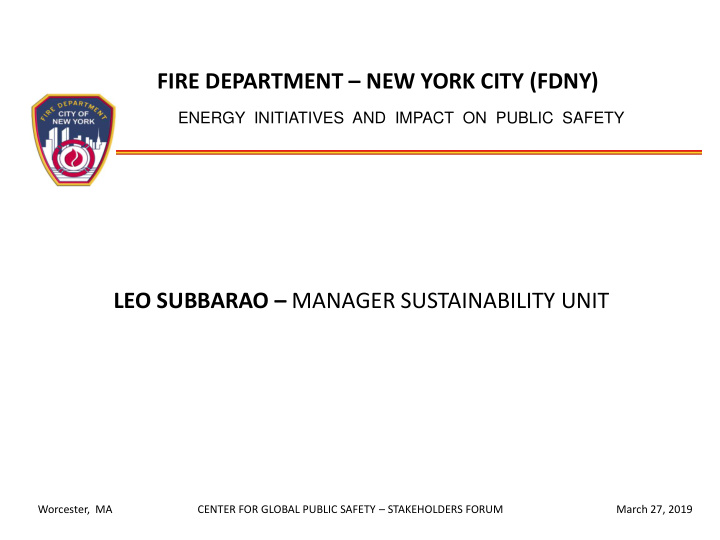



FIRE DEPARTMENT – NEW YORK CITY (FDNY) ENERGY INITIATIVES AND IMPACT ON PUBLIC SAFETY LEO SUBBARAO – MANAGER SUSTAINABILITY UNIT Worcester, MA CENTER FOR GLOBAL PUBLIC SAFETY – STAKEHOLDERS FORUM March 27, 2019
Safety Challenges • Fire • Explosion • Toxicity Batteries considered Li-Ion, Lead Acid(VRLA), Nickle Cadmium and Flow Batteries
Medium – FM Burn Test - Cabinet Small – Hoverboard Fire
Batteries and Thermal Runaway • Certain technologies susceptible to thermal runaway: • VRLA • NiCd and NiMH • Lithium Ion • Other technologies are not susceptible to thermal runaway, but can generate hydrogen • Flow batteries • Flooded Batteries
Dr. Rangaswamy Srinivasan John Hopkins Applied Physics Laboratory
Dr. Rangaswamy Srinivasan John Hopkins Applied Physics Laboratory
Dr. Rangaswamy Srinivasan John Hopkins Applied Physics Laboratory
STANDARD BESS DESIGN Worcester, MA CENTER FOR GLOBAL PUBLIC SAFETY – STAKEHOLDERS FORUM March 27, 2019
Rules and Regulations • NFPA 855 (Expected 2020) • International Fire Code (IFC Chapter 12) • NYC Regulations (Currently under development)
Rules and Regulations (cont.)
Rules and Regulations (cont.)
Required Listings and Test Method UL 1973 - Standard for Batteries for Use in Stationary, Vehicle Auxiliary Power and Light Electric Rail (LER) Applications UL 9540 - Standard for Energy Storage Systems and Equipment UL 9540A - Test Method for Evaluating Thermal Runaway Fire Propagation in Battery Energy Storage Systems
Questions? Thank You
Recommend
More recommend